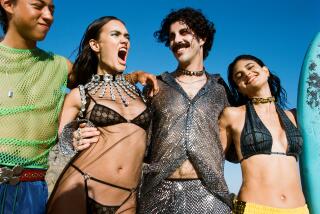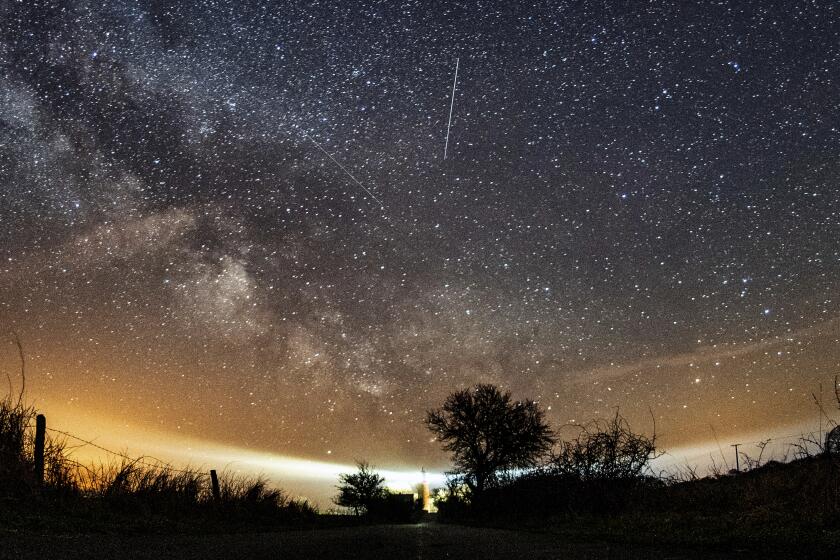He’s Always Ready to Ride Any New Wave That Breaks His Way
- Share via
HONOLULU — In 1949, a semester away from earning a degree in commercial art, Joe Quigg took stock of his life.
“I decided I needed a little daylight before I locked myself into a downtown Los Angeles office for the rest of my life,” he said recently over a cup of coffee at the Outrigger Canoe Club on Waikiki Beach.
“So I came over here to surf and relax for what I thought would be a summer. Instead, I never went back, except from 1959 to 1970, when I was in the surfboard business in Dana Point and Newport Beach.”
The Outrigger Canoe Club is Joe Quigg’s kind of place. Looking beyond the beach, one can see people on paddleboards and sailboards gliding over the water. On the beach, outrigger canoes are stacked on racks.
The club, which dates back to 1908, has an inscription at the front door that reads: “Let this be a place where man may commune with sun and sand and sea, where good fellowship and aloha prevail and where the sports of old Hawaii shall always have a home.”
Downtown Los Angeles’ loss, it turned out, was Hawaii’s gain. Here’s what Hawaii’s surfing guru, Fred Hemmings, said recently about Quigg, now 60:
“Joe Quigg is a great Hawaiian natural resource. Quigg, more than anyone else in Hawaii, has dedicated himself to seeing to it that the great canoe-building craftsmanship of the ancient Hawaiians isn’t lost for future generations.”
In any conversation of the history of surfing, both in Southern California and Hawaii, Quigg’s name is almost sure to come up. It also appears in the indexes of books on surfing. Anyone who surfed in Southern California in the 1940s and ‘50s knew about Joe Quigg.
He is also considered one of the world’s best designers of racing-class paddleboards. But in recent years, he has achieved notoriety of a different kind for his designs of one of the maritime world’s most remarkable vehicles:
The Hawaiian canoe.
Last October, about 50 outrigger canoes were entered in the annual 42.5-mile Molokai-to-Oahu race. Of the first 20 boats to finish, Joe Quigg designed 18.
Said Hank Lass, owner of a Honolulu firm called The Fiberglass Shop, which manufacturers outrigger canoes and paddles, and for whom Quigg designs canoes:
“Joe is a master craftsman and a master designer. When we ask him to design a certain type of canoe, we know we won’t get it quickly. He’s slow, in fact. He takes his time. But we do know one thing: The end result will be a very hot boat.”
Outrigger canoe racing in Hawaii is having something of a comeback.
Ancient Polynesians developed canoe building to an art form. They crossed thousands of miles of open Pacific in “voyager class” 60-foot canoes. They used smaller canoes for inter-island transportation, for fishing and for racing.
Captain James Cook, when he discovered Hawaii in 1778, reported seeing thousands of them when he sailed into Kealakakua Bay, on the big island of Hawaii.
But the skills of design, craftsmanship and maintenance of Hawaiian canoes died out, along with much of the other Hawaiian culture, when western culture swept the islands in subsequent decades.
Today, in mid-revival, outrigger canoe races in Hawaii and Southern California attract not only more entries than they did in recent decades, but better athletes, as well.
“The Molokai-to-Oahu race used to be just a few boats, and the guys in them would race the 42.5-mile course without having done any training at all,” Lass said. “Today, everybody takes it more seriously. The paddlers are in shape and most are well-conditioned athletes. Now, we’re seeing just how fast our boats can go.
“In 1952, there were three boats in the race. The winning time was 8 hours 55 minutes. The winning boat in the race last October made it in 5:12.”
According to Quigg, he learned in his surfboard-designing days that weight was everything. Today, in racing canoes, he has learned that design is everything.
“Let’s face it, water is awful stuff,” he said. “So to travel fast on it on a flat-surfaced vehicle like a surfboard, sailboard or paddleboard, weight is everything. When foam boards came in, the big, heavy wooden boards went out.”
Once, all Quigg wanted to do was design small sailboats.
“In 1959, Hobie Alter called me from Dana Point. He said he had 500 orders for boards and two employees. He liked the way I shaped boards, so I went back to work for him for a while. Then I wound up running a surfboard shop of my own (Joe Quigg Surfboards), on 31st Street in Newport Beach, from 1960 to 1970.
“In those years, what I really wanted to do was design and build small sailboats. But the surfboard business was so good, people wouldn’t let me get out of surfboards.”
Today, he marvels at the skill of practitioners of the fastest-growing aquatic sport in Hawaii, boardsailing.
“The little kids, and I mean 11-year-olds, I see in the water these days are just unbelievable to me . . . to have that kind of talent at that age,” he said.
So why doesn’t he try his hand at the sailboard business? He dismisses the notion with a wince.
“Oh, no. The technology in that business is changing every month. Some pretty big companies that aren’t right on top of the changes going on in design and technology are going broke. It’s too competitive right now.”
In 1974, a Honolulu Outrigger Canoe Club member, Cline Mann, wanted to revive the sport of paddleboard racing.
As a result, Quigg became a designer and builder of racing paddleboards, and the sport has experienced something of a revival in Hawaii. He made four for Mann, and roughly 20 for other club members. In the end, however, he abandoned paddleboards.
“It was a losing proposition,” he said. “Paddleboards take up too much space, time and money to build, and there wasn’t a big enough demand for them.”
But when he was designing and building paddleboards, no one could touch a Joe Quigg paddleboard.
Lass said: “After he built one or two, in the mid-1970s, all of a sudden Joe had about 20 people hounding him for paddleboards. And you never saw anyone so thorough.
“He was always aware of the shipping schedules and knew when a shipload of balsa timber was coming into Honolulu. And he’d be there at the lumberyard, waiting for the delivery truck. He’d inspect all of it before choosing just the right board.”
His next stop was catamarans.
“He designed a two-man catamaran for himself, then built a big one that wound up being owned by Joey Cabell, who was a founder of the Chart House restaurant chain,” Lass said.
“That boat set a record, sailing from Hawaii to Tahiti. A little after that, we were looking for someone to design outrigger canoes for us. After I saw what he’d done with that catamaran, I knew he was the guy we wanted.”
Shortly thereafter, Quigg learned that design was the thing in outriggers.
“In the long-distance outrigger races, all the boats are limited to a minimum of 400 pounds, to even things out competitively,” he said.
“So I approached the design of my boats with the idea that skinny is everything. But the boats had to be just right on the skinny side. If you go too skinny, the boats become awkward, they become ‘cranky’ on the water, and you lose performance.
“So I designed them one inch fatter than (the thinnest dimension) the rules allowed, so that you wind up with a canoe that girls can manage as well as the men. I found that if you went as skinny as the rules permit, girls have a tough time turning the boat.”
Lass said: “Joe’s outriggers are dominating the sport because he can bring his boats closer to the rules specifications than anyone else.
“The boats have to be a maximum of 43 feet 4 inches long, for example. Most builders come up short because they’re afraid to cut it too fine. Joe’s boats come out a tiny fraction of an inch short of 43-4. That’s craftsmanship. He can cut it finer than anyone else.”
Since everything Quigg has touched in aquatic sports has been successful, why not try designing the ultimate 12-meter sailboat, so those impertinent Australians will never win the America’s Cup again?
“I don’t think Quigg would thrive in the 12-meter environment,” Lass said. “Joe’s a go-slow guy, and all those 12-meter people are in a big hurry. They want it now. Joe needs time. Now, if you wanted a 12-meter out of him and you gave him all the time he wanted, there’s no doubt in my mind he’d give you a hell of a boat.”
In 1984, the prize for the winning canoe of the Molokai-to-Oahu race was a koa tree log, suitable for turning into an outrigger canoe. Naturally, one of Quigg’s boats won.
Now, he’s working on a dream project, the hand-carving of a canoe from the same wood used by ancient Hawaiians. Koa, a member of the acacia family, is a hardwood. Koa forests, once dense in Hawaii, are now vanishing, and koa is hard to come by.
“Joe is in his element now,” Lass said. “He’s wanted to build a canoe from a koa log for years, and now he’s doing it. He said he just loves working with the wood. And the challenge has him excited, too, because there’s no way to predict what will happen. The whole thing could warp . . . or it could be the fastest canoe in history.”
Quigg is a private man who intensely dislikes talking about his achievements and recoils at the very thought of a newspaper article being written about him. He submitted to an interview only after repeated pleadings. But when told afterward that a photographer would be dispatched to photograph him, he threw up his hands in horror.
“Oh, no!” he pleaded, “Please, all I want to do is go lie down someplace.”
More to Read
Sign up for The Wild
We’ll help you find the best places to hike, bike and run, as well as the perfect silent spots for meditation and yoga.
You may occasionally receive promotional content from the Los Angeles Times.






